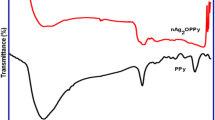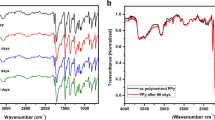Abstract
The electrical resistance of PPy films synthesized in the presence of sodium dodecyl sulfate (SDS) surfactant and sodium sulfate (Na2SO4) as oxidant was analyzed in the temperature range of 24 to 80 °C. PPy was electrochemical synthesized for 20 and 60 min by using stainless steel electrodes immersed in a glass tubular reactor. A solution was prepared in deionized water with 0.1 M SDS, 0.1 M pyrrole, and Na2SO4 at 0.05 M or 0.1 M. Infrared spectra of PPy were recorded by using Fourier Transform Infrared spectroscopy. PPy granular morphology was observed with scanning electron microscopy (SEM). Electrical resistance was measured with a two-point probe method in the range 24 to 80 °C; the best value obtained was 0.2 Ohm of the sample synthesized in the presence of SDS with 0.05 M of Na2SO4 concentration.
Graphical abstract

Similar content being viewed by others
Explore related subjects
Discover the latest articles, news and stories from top researchers in related subjects.Avoid common mistakes on your manuscript.
Introduction
Conducting polymers have been of great attention for their unique properties that combining the attributes to polymers with the characteristic of transport electrical charges. Among the intrinsic conducting polymers, PPy is a promising polymer due to its straightforward polymerization, environmental stability, and high electrical conductivity [1,2,3]. PPy is widely researched for potential applications in different areas such as dye-sensitized solar cells [4, 5], supercapacitors [6], gas sensors [7], and microelectronic actuators [8]. PPy can be produced in different forms like powder [9], nanoparticles [10], or films [11]. PPy films can be easily obtained by electrochemical polymerization [12]. The properties of PPy films such as electrical, thermal, and morphological can be controlled by manipulating of the synthesis parameters. Indeed, type oxidant, dopant or surfactant, polymerization time, polymerization temperature, electrode size, and monomer concentration are key factor influencing the electrical conductivity [13].
Recently, Yussuf et al. [14] studied the influence of different oxidants and monomer concentrations on the PPy properties. It was observed that oxidants decrease the electrical resistance as the temperature increases, leading to an improvement in the electrical conductivity. Several researches have studied the effect of the surfactants in the PPy synthesis to give a better appearance and mechanical stability and to increase its electrical conductivity. Pandit et al. [15] synthesized PPy in the presence of different surfactants and found a higher conductivity when SDS surfactant was used. In this work, it is reported the study of the electrical resistance at different temperatures of PPy films synthesized in the presence or absence of SDS surfactant and the effect of two different concentrations of Na2SO4.
Materials and methods
PPy films were electrochemically synthesized for 20 and 60 min in a glass tubular reactor with two stainless steel electrodes separated 5 mm from each other, employing a 3 cm diameter working electrode and an 8 cm diameter counter electrode, and the potential applied was limited to 5 V and 40 mA. The solution for PPy synthesis was prepared at 70 ml with DI water, 0.1 M pyrrole (Sigma Aldrich, 98%), 0.1 M SDS surfactant (Sigma Aldrich, 99%), and 0.1 M or 0.05 M Na2SO4 (Fermont, 99.8%). The mixture was stirred for 20 min until homogeneous on a Cimarec Thermo Scientific magnetic stirrer. After synthesis, the films were washed with ethanol, dried under an infrared lamp for 5 min and separated for their characterization. PPy morphology was analyzed by using a JEOL JSM6610LV microscope, infrared spectra were recorded with a Varian 640-R FTIR spectroscopy, and the electrical resistance was measured each 2 °C in the range from 24 to 80 °C with a homemade copper plates test head and a Steren UT55 Mul-270 multimeter and the film's thickness was measured with a Mitutoyo Digital H-2780 µm. In order to simplify the text, the films synthesized with 0.1 M Na2SO4 will be defined as PPy0.1 and those with 0.05 M Na2SO4 as PPy0.05.
Results and discussion
Synthesis and aspect
PPy films synthesized in the absence of SDS have rough and brittle appearance, and their average thickness is 186 μm, whereas the films synthesized in the presence of the surfactant have a smoother appearance and are not as susceptible to breakage, and their thickness is 62 and 228 μm for the PPy0.05 films synthesized at 20 and 60 min, respectively. The film becomes thicker with increasing synthesis time due to the drag in process, promoting an overgrowth of the polymer [16, 17]. It was observed that the initial voltage in the reaction was of 2.00 V, while the final voltage was about 2.15 V when using the controlled separation of 5 mm between the electrodes, if this gap changes, the initial and final voltage too.
Morphology
Fig. 1 shows the morphology of PPy0.05 synthesized at 20 min in the absence 1 (a) and the presence 1 (b) of the SDS surfactant. The characteristic granular morphology of PPy is presented in both images, PPy0.05 without SDS possesses a semispherical morphology [18, 19], while the PPy0.05 with SDS presents more particles agglomeration resembling to a cauliflower-like structure [15]. The morphologies of PPy0.1 synthesized at 20 min and 60 min are shown in Fig. 1c and d, respectively. The same cauliflower-like morphology that PPy0.05 with SDS presents can be observed. This particles agglomeration could be attributed to the surfactant, which leads to enhanced polymer growth on the working electrode.
FTIR analysis
The infrared spectra of PPy films synthesized with (Fig. 2, blue line) and without SDS (Fig. 2, black line) show the characteristic absorption bands of PPy and SDS, corroborating the formation of the polymer. N–H vibration peak was seen at 779 cm−1 [20], while the C–H band was seen at 1039 cm−1 [21]. The presence of C–C stretching band was recorded at 1110 cm−1 [22] and the C=C pyrrole ring stretching at 1546 cm−1 [23]. On the other hand, PPy synthesized with SDS presented the following peaks, N–H vibration at 827 cm−1, C–H deformation at 998 cm−1, C–C stretching at 1121 cm−1, and C=C stretching at 1522 cm−1. There were two other absorption bands detected in PPy with SDS that correspond to the SDS sulfonate group at 1251 cm−1 [24] and the characteristic C–H stretching of the SDS alkyl tail at 2844 and 2926 cm−1 [25].
Resistance of PPy films
A change on the electrical resistance of PPy films was observed when using SDS in the synthesis of the polymer. The resistance of PPy0.1 synthesized without SDS decreases as a function of temperature with values between 467 and 420 Ω (Fig. 3a, blue line); this implies an increment on the electrical conductivity [21]. The PPy0.1 film synthesized with SDS surfactant presented a diminution on the electrical resistance but with a temperature dependency similar to conductor materials, the values attached by this sample are between 4.8 and 8.2 Ω (Fig. 3a, orange line). On the other hand, PPy0.05 film synthesized without SDS exhibited a similar behavior than PPy0.1 film but with the resistance values in the range of 270 and 190 Ω (Fig. 3a, black line). Finally, PPy0.05 film with SDS presented a resistance of 0.2 Ω, this is the lower resistance measured and did not exhibit change with temperature [14].
PPy films synthesized for 60 min (Fig. 3b) exhibited similar resistance values with the same incremental behavior as a function of temperature than the other samples with SDS surfactant. The resistance of the PPy0.1 film was a bit smaller than the synthesized for 20 min, while the PPy0.05 resistance was higher. The diminution of PPy0.1 and PPy0.05 electrical resistance is attributed to the addition of SDS surfactant in the synthesis of the polymer [26].
Conclusions
In the present study, PPy films were successfully synthesized by the electrochemical oxidation method varying the oxidant concentration and the presence of SDS surfactant during the synthesis. The results provided by SEM confirm the granular morphology characteristic of PPy and the FTIR spectra show absorption bands coincident to their chemical composition. The use of SDS surfactant in the synthesis furnishes a more even aspect to PPy films and make them less susceptible to breakage; furthermore, the films with SDS have much lower resistances than those synthesized without it. Synthesis time also plays an important role on the aspect of the films, since the more the synthesis lasts, the thicker the film is. It was found that the films synthesized with 0.05 M of Na2SO4 concentration have lower resistance values than those with 0.1 M, the lowest resistance attached was of the PPy films synthesized in the presence of SDS surfactant for 20 min with 0.05 M of Na2SO4 concentration.
Data availability
The datasets generated during the current study are available in the ScienceDirect repository, https://www.sciencedirect.com/.
References
A.G. Maciarmind, J. Chem. Soc. Chem. Commun. (2001). https://doi.org/10.1002/1521-3773(20010716)40:14<2581::AID-ANIE2581>3.0.CO;2-2
D. Zhang, Z. Wu, X. Zong, Y. Zhang, Sens. Actuators B Chem. (2018). https://doi.org/10.1016/j.snb.2018.08.001
S.A. Khan, L. Li, D. Zhao, S. Chen, React. Funct. Polym. (2020). https://doi.org/10.1016/j.reactfunctpolym.2020.104483
N. Sangiorgi, A. Sangiorgi, F. Tarterini, A. Sanson, Electrochim. Acta (2019). https://doi.org/10.1016/j.electacta.2019.03.059
J. Wu, S. Wu, W. Sun, Electrochem. Commun. (2021). https://doi.org/10.1016/j.elecom.2020.106879
W. Wu, L. Yang, S. Chen, Y. Shao, L. Jing, G. Zhao, H. Wei, RSC Adv. (2015). https://doi.org/10.1039/C5RA17036B
A.A. Yadav, S.B. Kulkarni, C.D. Lokhande, Polym. Bull. (2018). https://doi.org/10.1007/s00289-018-2282-5
D. Pang, X. Wang, C. Liu, H. Xu, G. Chen, F. Du, Y. Dall’Agnese, Y. Gao, Appl. Surf. Sci. (2022). https://doi.org/10.1016/j.apsusc.2021.152403
B. Gowtham, V. Ponnuswamy, G. Pradeesh, R. Suresh, S. Ramanathan, S. Ashokan, J. Inorg. Organomet. Polym. Mater. (2020). https://doi.org/10.1007/s10904-019-01408-5
H. Yu, Y. He, G. Xiao, H. Li, X. Mei, Y. Cheng, F. Zhong, L. Zhou, J.Z. Ou, Sep. Purif. Technol. (2021). https://doi.org/10.1016/j.seppur.2021.118933
E. Villani, N. Shida, S. Inagi, Electrochim. Acta (2021). https://doi.org/10.1016/j.electacta.2021.138718
M. Aghazadeh, M.G. Maragheh, M.R. Ganjali, P. Norouzi, F. Faridbod, Appl. Surf. Sci. (2016). https://doi.org/10.1016/j.apsusc.2015.12.146
A. Ling, A. Arsad, M. Ahmadipour, Polym. Adv. Technol. (2021). https://doi.org/10.1002/pat.5201
A. Yussuf, M. Al-Saleh, S. Al-Enezi, G. Abraham, Int. J. Polym. Sci. (2018). https://doi.org/10.1155/2018/4191747
V.K. Pandit, N.M. Soudagar, C.D. Lokhande, S.S. Joshi, Mater. Today: Proc. (2020). https://doi.org/10.1016/j.matpr.2020.02.023
A. Kaynak, Mater. Res. Bull. (1997). https://doi.org/10.1016/S0025-5408(96)00200-0
X. Jian, H. Yang, J. Li, E. Zhang, Z. Liang, Electrochim. Acta (2017). https://doi.org/10.1016/j.electacta.2017.01.082
M. Rajesh, C.J. Raj, B.C. Kim, B.B. Cho, J.M. Ko, K.H. Yu, Electrochim. Acta (2016). https://doi.org/10.1016/j.electacta.2016.10.118
M. Kolya, M. Faisal, C.K. Madhusudhan, K. Mahendra, N. Raghavendra, M. Revanasiddappa, J. Mater. Sci.: Mater. Electron. (2022). https://doi.org/10.1007/s10854-021-07466-1
R.J. Young, Introduction to Polymers (Springer, New York, 1981)
M.A. Chougule, S.G. Pawar, P.R. Godse, R.N. Mulik, S. Sen, V.B. Patil, Soft Nanosci. Lett. 1, 6–10 (2011)
M.K. Singh, A. Agarwal, R. Gopal, R.K. Swarnkar, R.K. Kotnala, J. Mater. Chem. (2011). https://doi.org/10.1039/C1JM12320C
D.F. Nabila, M.N. Siti, A.R. Jahwarhar, V.F. Knight, W.Y. Wan, K.O. Keat, M.K. Noor, S. Taufik, A. Samsuri, J.S. Intan, W. Latip, Adv. Mater. Sci. Eng. (2020). https://doi.org/10.1155/2020/8762969
Y. Chen, S. Wang, L. Kang, L. Kong, RSC Adv. (2016). https://doi.org/10.1039/C5RA21407F
A.V. Syugaeva, N.V. Lyalinaa, A.N. Maratkanovaa, A.G. Kurenyab, Synth. Met. (2020). https://doi.org/10.1016/j.synthmet.2020.116350
P.G. Sari, M.A. Elita, A. Manaf, A. Manar, IOP Conf. Ser.: Mater. Sci. Eng. (2019). https://doi.org/10.1088/1757-899X/553/1/012042
Author information
Authors and Affiliations
Corresponding author
Ethics declarations
Conflict of interest
On behalf of all authors, the corresponding author states that there is no conflict of interest.
Additional information
Publisher's Note
Springer Nature remains neutral with regard to jurisdictional claims in published maps and institutional affiliations.
Rights and permissions
Springer Nature or its licensor (e.g. a society or other partner) holds exclusive rights to this article under a publishing agreement with the author(s) or other rightsholder(s); author self-archiving of the accepted manuscript version of this article is solely governed by the terms of such publishing agreement and applicable law.
About this article
Cite this article
Poblette-Almazán, L.D., Moreno-Saavedra, H., Hernández-Tenorio, C. et al. Electrical resistance of electrochemical synthesized polypyrrole in the presence of sodium dodecyl sulfate surfactant. MRS Advances 7, 1150–1153 (2022). https://doi.org/10.1557/s43580-022-00451-8
Received:
Accepted:
Published:
Issue Date:
DOI: https://doi.org/10.1557/s43580-022-00451-8







